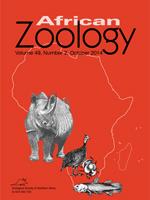The complex life cycles of most trematode parasites include three hosts. The first intermediate host is a snail, the second is normally a teleost fish and a piscivorous bird serves as the definitive host. Lymnaeid snails are most likely to be responsible for cercarial shedding, which infect exposed fish and in turn are eaten by piscivorous birds. From 2008 to 2010 fish in the Okavango and Orange-Vaal River Systems were collected and dissected in order to determine the prevalence and intensity of larval trematode infections in the eyes and brains. This paper discusses the possible ecological factors which can influence the probability of certain fish species becoming infected with diplostomid cercariae and hence metacercariae. The feeding strategies and sizes of piscivorous birds, which could act as definitive hosts for the adult worms, are summarized and discussed. Information on the snail species responsible for furcocercous cercarial shedding in the two study sites is also included.
BioOne.org will be down briefly for maintenance on 12 February 2025 between 18:00-21:00 Pacific Time US. We apologize for any inconvenience.
How to translate text using browser tools
1 October 2014
Ecology of Diplostomid (Trematoda: Digenea) Infection in Freshwater Fish in Southern Africa
Andri Grobbelaar,
Liesl L. Van As,
Hennie J.B. Butler,
Jo G. Van As
ACCESS THE FULL ARTICLE

African Zoology
Vol. 49 • No. 2
October 2014
Vol. 49 • No. 2
October 2014
diplostomids
ecomorphological groups
Fish
Okavango
Orange-Vaal




